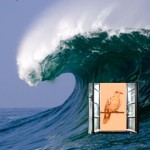 Unusual worlds are opening. I’ve been journeying along one of my less-traveled paths, returning to a lifelong love of fantastical stories. Clues to my own emerging voice pop out of page and screen. This post’s trip report has links to a few favorites, some notes on writing and consciousness, and a little peach-flavored magic realism.
Unusual worlds are opening. I’ve been journeying along one of my less-traveled paths, returning to a lifelong love of fantastical stories. Clues to my own emerging voice pop out of page and screen. This post’s trip report has links to a few favorites, some notes on writing and consciousness, and a little peach-flavored magic realism.
The journey into “speculative fiction” wanders through sci-fi and fantasy, sometimes magic realism, all inside a myth-creating bubble. A one-word genre for the big-bubble type is mythopoeia. Zen teaching stories and the wild tales of Nasruddin might fit in here too.
I stepped back into this mysterious forest of the imagination at Ursula K. LeGuin’s website, where I found many treasures – her own work (adding to what I’d known) plus references to writers she’s reviewed. A major find was her book The Wave in the Mind, with its exuberant and frequently hilarious essays on writing. The title comes from her expansion of Virginia Woolf’s image of inspiration coming in rhythmic waves:
UKL quoting Woolf [page 281]: “[T]he writer’s job is to go down deep enough to begin to feel that rhythm … to be moved by it, and let it move memory and imagination to find words … to recognize the wave, the silent swell, way out at sea, way out in the ocean of the mind, and follow it to shore, where it can turn or be turned into words, unload its story, throw out its imagery, pour out its secrets. And ebb back into the ocean of story.”
Someone who’s done this is Kij Johnson, another find on the UKL site. In her work, I experience what James Joyce called “aesthetic arrest”: the stillness of being awestruck by art. Story after story in At the Mouth of the River of Bees stunned me this way – all so different, intelligent, elegant, most of them plunging into the heart core. (She’s posted some, if you want a taste.) This led me to her novel Fox Woman, also startling and vivid, with complicated wisdom floating inside simple (if exotic) surfaces.
These new experiences enrich a long, deep “vein of gold” in me, the discovery of such veins being the prize for creatives who notice what lights them up in other people’s work. I traced my sci-fi/magical vein back through the ‘80s and ‘90s (after the Seuss-Disney years and original “Star Trek”), finding One Hundred Years of Solitude and most of Philip K. Dick’s work along the way (Minority Report being a favorite movie adaptation of PKD’s stories). Expanding the search, Ms. Le Guin’s enthusiasm for Jorge Luis Borges re-opened that long-lost path: two favorites are “The Garden of Forking Paths” and “Tlon, Uqbar, Orbis Tertius”. They hold me in aesthetic arrest (literally unable to move, after reading them).
Why was I transfixed? In Borges’ mythical land of Tlon, for example, my eyes bugged out when I read about their language: it has no nouns – only aggregates of adjectives to describe phenomena, clusters of qualities that assemble and dissolve instantaneously (like real life, beneath our usual notice). The morning after I read about Tlon, I woke at dawn and saw outside the window a deep-peach-colored dove that glowed, for the moment, in sunrise tints. First I marveled at the synchronicity, this living illustration of surprisingly mixed adjectives coming so soon. I marveled again at the genius (Borges) that had ventured into the farthest ocean of the mind, and recognized the wave – humans creating and destroying worlds by perception alone – and followed it to shore, where it threw out its imagery: a language of adjectives that morph and recombine, moment to moment, nounless.
In magic realism, it would be clear the momentary sunrise-peach dove had awakened me on purpose. The best speculative fiction affects me this way, inviting me into subtle mysteries.